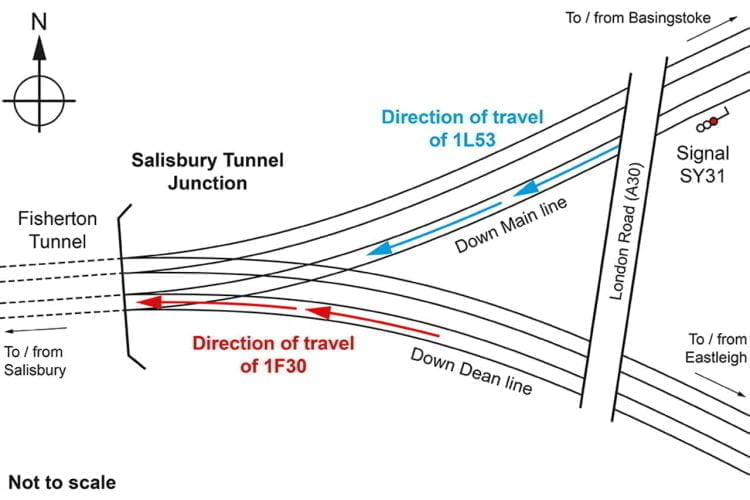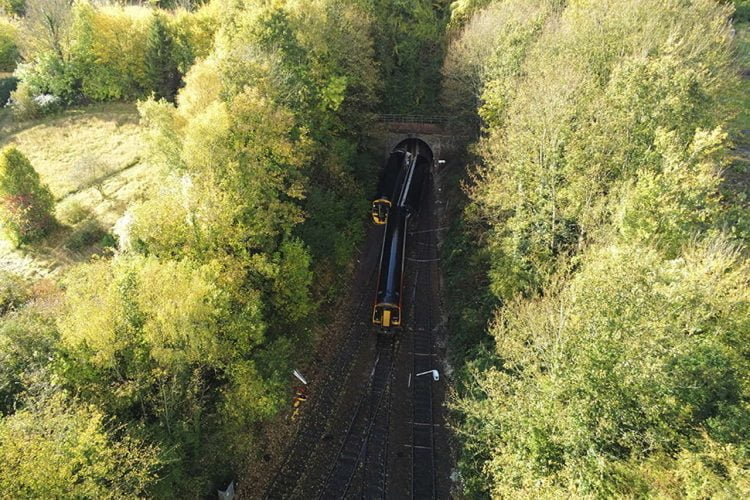The Rail Accident Investigation Branch has released its preliminary findings of its investigation into the crash between two trains in Salisbury last weekend.
At around 18:45, on the 31st October 2021, 1L53, the 17:20 South Western Railway service from London Waterloo to Honiton collided with the side of 1F30, the 17:08 Great Western Railway service from Portsmouth Harbour to Bristol Temple Meads.
The collision took place at Salisbury Tunnel Junction, on approach to Fisherton Tunnel.
Tunnel Junction allows the Up and Down Dean Lines from Eastleigh to merge with the Up and Down lines from Basingstoke.
The RAIB has found that 1F30 was using the junction to join the Down Main Line from the Down Dean Line, while 1L53 was approaching Tunnel Junction from the Down Main Line from Basingstoke.

The collision impact caused the front two coaches from 1L53 and the rear two coaches from 1F30 to derail and both trains then continued into Fisherton Tunel following the collision before they both came to an eventual stop.
Thirteen passengers and the driver required hospital treatment as a result of the collision, which has also caused significant damage to the infrastructure and trains.
The preliminary examination has found that 1F30’s movement across Tunnel Junction was protected by a red signal (SY31). 1L53 passed this signal at danger by around 220 metres.
Analysis of the On Train Data Recorder (OTDR) has found that the driver initally applied service braking to slow the train on approach to the caution signal before signal SY31.
After 12 seconds of service braking, the driver made an emergency brake demand as the train was slipping on the rails. As the train approached signal SY31, with the emergency brake still being demanded from the driver, a second emergency brake demand was made by the Train Protection and Warning System (TPWS). Both of these demands did not prevent the train from reaching the junction.

OTDR analysis by the RAIB has shown that wheel slide was present both when service braking was applied and after the emergency brake was demanded.
The RAIB says this is almost certainly a result of low adhesion, as we reported yesterday.
The full investigation will look to identify the events leading up to the crash and:
- the level of wheel/rail adhesion present on the approach to Salisbury Tunnel junction
- the status and performance of the braking, wheel slide protection and sanding systems on train 1L53
- the behaviour of both trains during and following the collision
- South Western Railway’s policies relating to low wheel/rail adhesion
- Network Rail‘s policies relating to low wheel/rail adhesion and how they managed the risk of low adhesion in this area
- the processes used to assess and control the risk of overrun at signal SY31
- any relevant underlying factors, including any actions taken in response to previous safety recommendations.
The findings will be published in a full report on the RAIB website.
Where Next?
RAILADVENT NEWS
The latest railway news
RailAdvent Plus
Discounts, videos, pictures and more!
FREE NEWSLETTERS
Signup to our daily and weekly newsletters
RAILADVENT SHOP
Railway Prints, DVD’s / Blu-Ray’s, books and more
LOCOSTOP COMMUNITY
Come and share your railway pictures
UK STEAM INFO
Upcoming mainline steam tours/loco movements






Responses
It seems foolish, anyway, to have such a junction so close to a tunnel.